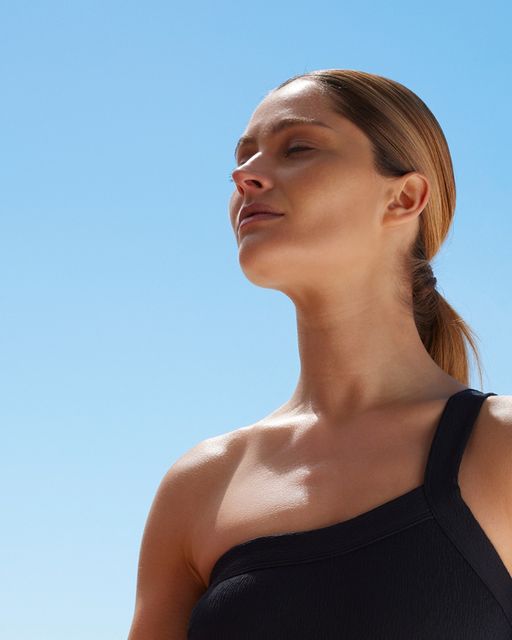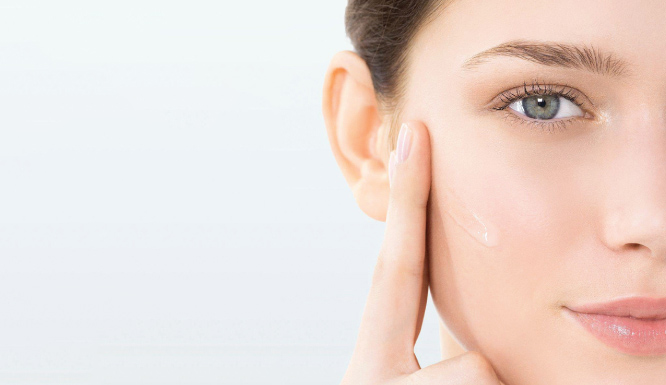
PHOTOAGING: DEFINITION, CAUSES AND SOLUTIONS
Everything you need to know about photoaging
What is photoaging?
General skin aging is an internal and natural process that occurs with age. In contrast, photoaging of the skin is caused by external factors, primarily overexposure to UV rays. According to the Skin Cancer Foundation, photoaging is responsible for 90% of visible changes in our skin. It is most noticeable in the areas most exposed to the sun : the face, neck, arms, and hands.
Wrinkles and loss of skin elasticity
UV rays damage collagen and elastin fibers, leading to a decrease in skin firmness and elasticity. Fine lines and wrinkles then appear, particularly around the eyes, mouth, and forehead.
Hyperpigmentation of the skin
When skin is repeatedly exposed to the sun excessively, it protects itself from UV rays by producing excessive amounts of melanin. This results in dark spots or areas of uneven pigmentation on the skin, often called age spots or sunspots .
Melasma
Melasma is a form of facial hyperpigmentation that appears as widespread, brownish or grayish patches, often on the cheeks, forehead, chin, and upper lip.
Freckles
Photoaging can intensify the color of freckles or cause new ones to appear, making them more visible.
Actinic keratosis
A consequence of intense and repeated exposure to the sun, actinic keratosis is considered a precancerous lesion. These are rough, scaly, and sometimes pigmented areas of the skin that do not heal spontaneously. It is essential to consult a dermatologist, who is the only one who can treat them.
More visible blood vessels
Photoaging can also cause dilation of subcutaneous blood microvessels, making them more visible and possibly giving the skin a reddish or mottled appearance.
Causes of photoaging: beware of the sun
The sun provides warmth, light, and vitamin D, and its impact on our well-being is well-established. However, it's important to take precautions before exposing yourself to the sun, as its rays are the main cause of photoaging and, more seriously, skin cancer.
The role of UVAs
UVA rays are present throughout the day, pass through windows and penetrate deep into the skin. They are the main cause of photoaging. By altering the structure of collagen and elastin, they lead to a decrease in the firmness and elasticity of the skin, which promotes the appearance of wrinkles, fine lines and pigment spots .
Please note that tanning under a UVA lamp or sunbed is a high-risk practice. 50 to 70% of skin cancers are directly linked to overexposure to UVA/UVB rays.
The impact of UVB rays
UVB rays are more intense during hours of strong sunlight. Being shorter, they mainly affect the upper layers of the skin and are responsible for sunburn and tanning, the skin's natural protective response to the sun. They contribute to skin photoaging by damaging cell DNA, causing deep wrinkles, sunspots, and loss of skin elasticity .
The effects of HEV
High-Energy Visible Light (HEV), including the famous blue light, penetrates deep into the skin. By generating free radicals, it causes oxidative stress and cellular damage that can lead to a decrease in collagen production, an increase in pigmentation, and a deterioration of the skin barrier. Blue light is emitted by the sun but also by our phone screens, computers, etc.
The role of infrared light
Exposure to infrared light can also contribute to skin photoaging by causing cellular damage and inflammation in the skin. These effects can lead to decreased collagen production, increased pigmentation, and a deterioration of the skin barrier.
In addition to sun exposure, other factors can influence skin photoaging.
The role of phototype and genetics
Skin phototype determines its sensitivity to UV rays, so lighter skin will be more susceptible to photoaging. Additionally, some people have a genetic predisposition that makes them more vulnerable to photoaging. These may be genes related to skin pigmentation, DNA repair, or sensitivity to UV rays.
The effects of age
Although photoaging can affect people of any age, it is more common in older adults due to cumulative unprotected sun exposure throughout their lives. With age, the skin gradually loses its ability to regenerate and protect itself from environmental damage, making it more vulnerable.
Extrinsic factors
In addition to intrinsic factors, external factors can influence skin photoaging.
The role of the environment
People who work outdoors are, in fact, more exposed to high levels of UV radiation, which can accelerate the skin aging process.
The impact of smoking
Numerous studies have demonstrated the impact of smoking on photoaging. Chemicals in cigarette smoke can damage the skin's collagen and elastin, leading to a loss of firmness and the premature appearance of wrinkles.
The harms of alcohol consumption
Certain medications, such as antibiotics and photosensitizing drugs, can make the skin more sensitive to UV rays and thus increase photoaging.
How to prevent photoaging?
While natural aging cannot be stopped, it is possible to combat photoaging since it is mainly due to external factors.
Using the right sunscreens to combat photoaging
To effectively protect your skin against photoaging, it's essential to select products that are tailored to your skin type and its specific needs. Look for products rich in antioxidants such as vitamin C and vitamin E, which help neutralize free radicals and prevent damage caused by UV rays and other environmental aggressors. Also, look for sunscreens containing zinc oxide and/or titanium dioxide, as these ingredients offer broad-spectrum protection against UV rays. These compounds work by forming a physical barrier on the skin, reflecting and scattering the sun's rays for optimal protection.
Drawing on this expertise, Institut Esthederm has developed unique sun care products that allow you to fully enjoy the benefits of the sun while preserving the youthfulness and health of your skin. Designed to help the skin fight photoaging while strengthening its natural defences, our treatments incorporate patents and advanced cellular technologies.
Patented Global Cellular Protection technology optimizes the skin's natural protective mechanisms and strengthens skin cells' resistance to sun damage. Protect your skin and preserve its youthfulness with our treatments. Certain products provide a luminous, long-lasting tan while reducing fine lines and wrinkles and protecting the skin from oxidative stress and cellular damage. Reapply your sunscreen regularly to maintain optimal protection.
And don't forget to protect your skin whatever the season , because UVA rays, the main cause of photoaging, affect the skin all year round.
Protect yourself from the sun
When outdoors, wear clothing and accessories that will help protect you from the sun: a wide-brimmed hat and sunglasses to protect your skin and eyes from UV rays, and long-sleeved clothing to cover your skin. Avoiding excessive sun exposure can help reduce the risk of photoaging. Limit time spent outdoors between 10 a.m. and 4 p.m. when UV rays are strongest and seek shaded areas.
Prioritize a healthy lifestyle
Maintaining a healthy lifestyle is also essential for preventing photoaging. Eating a balanced and nutritious diet rich in fruits, vegetables, whole grains, and lean protein sources provides the skin with the essential nutrients it needs for healthy skin. Regular physical activity also promotes good circulation and contributes to glowing, radiant skin. Finally, avoid smoking and excessive alcohol consumption, and make sure you get enough sleep each night to allow your skin to regenerate and repair itself.
Stock up on antioxidants
Antioxidants, such as vitamin C, vitamin E, and polyphenols, play a crucial role in fighting free radicals and oxidative stress. Eat a diet rich in fruits, vegetables, berries, nuts, seeds, and green teas, which are particularly beneficial for skin health.
If the signs of photoaging are already visible, several treatments are available to reduce its effects.
The regenerative power of Retinol
Retinol, derived from vitamin A , is the most powerful active ingredient to fight the signs of photoaging. Its regenerative and firming properties promote cell renewal, stimulate collagen production and reduce the appearance of wrinkles and fine lines. After a period of sun exposure, we recommend you do an Intensive Retinol Treatment. It includes two complementary treatments to be applied every day for two months:
- A fast-release concentrated retinol serum (0.3%)
- A cream containing time-release retinol.
Your skin will then appear smoother, more radiant and more toned .
Laser treatments
Laser treatments can also combat the signs of photoaging. There are two types of lasers:
· Ablative lasers remove the surface layers of the skin, stimulating the regeneration of new skin cells. They are effective in treating deep wrinkles, acne scars, and other skin texture problems.
· Non-ablative lasers penetrate the skin without damaging the outer layer. They heat the deeper layers of the skin to stimulate the production of collagen and elastin, improving skin firmness and texture.
Dermabrasion
Dermabrasion is an exfoliating treatment that uses a rotating device to remove the surface layers of skin damaged by photoaging, revealing smoother, younger-looking skin underneath. This technique can reduce wrinkles, scars, and sunspots , and improve skin texture and brightness.
Peelings
Chemical peels can also treat photoaging. Exfoliating acids are used to remove dead skin cells, promoting cell renewal and improving skin texture and radiance. These peels can be customized to individual skin needs and the severity of skin damage.
